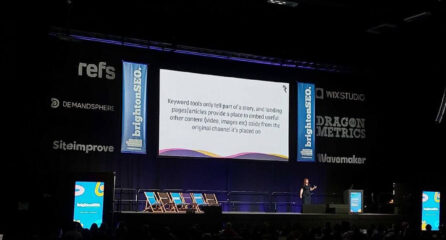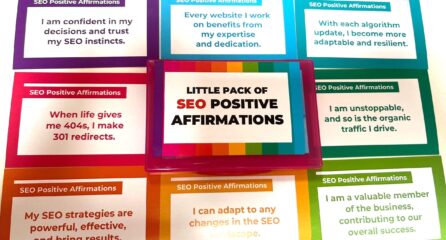If you’re reading this, your company’s growth has probably already benefited from strategic SEO and it’s stood you in great condition. Now you’re looking at expanding your SERPS (search engine results page) visibility in other parts of the world – and this article will help you do just that.
In this article, we’ll look at the best way to lay the groundwork for a successful international SEO campaign. We’ll look at everything from preliminary market research, technical considerations, international SEO keyword research, regional-relevant content and how to build genuine local backlinks to win you local trust in a search engine’s eyes.
What is international SEO & why do you need it?
International SEO is a specific SEO strategy for creating and maintaining an organic presence in the SERPS in different countries. It’s an ongoing activity that works to maintain a technically healthy website, create linguistically relevant content, strong authoritative backlinks and optimum user experience.
How is international SEO different from normal SEO?
Essentially international SEO shares the same fundamentals as regular SEO, but the key to this definition lies within the words “regionally relevant”.
As with regular SEO, the search engines (regardless of where they operate), have one mission: to match search intent with the most relevant content.
For argument’s sake, let’s say you operated a country-focused website for Spain written in Spanish. A search engine would recognise you as a national Spanish entity and group you into the Spanish niche for your particular market. In order to rank highly for your desired keyword terms, you would need to produce content that is high value to Spanish speakers. You would also have to gain backlinks from local sources in order to signal to search engines that you are a worthy local contender. In this sense, international SEO could be defined as multiple simultaneously successful local SEO campaigns.
International SEO considerations
Before you start to plan an international SEO campaign, consider the following questions.
Is there an organic demand for your services?
Any decision to go global should always be informed by solid research and website data. International SEO can be an expensive investment – so be sure that there’s a demand for your services in the regions you want to target.
You can use Google Analytics to see where your non-native website traffic is coming from under the Audience > Geo > Location
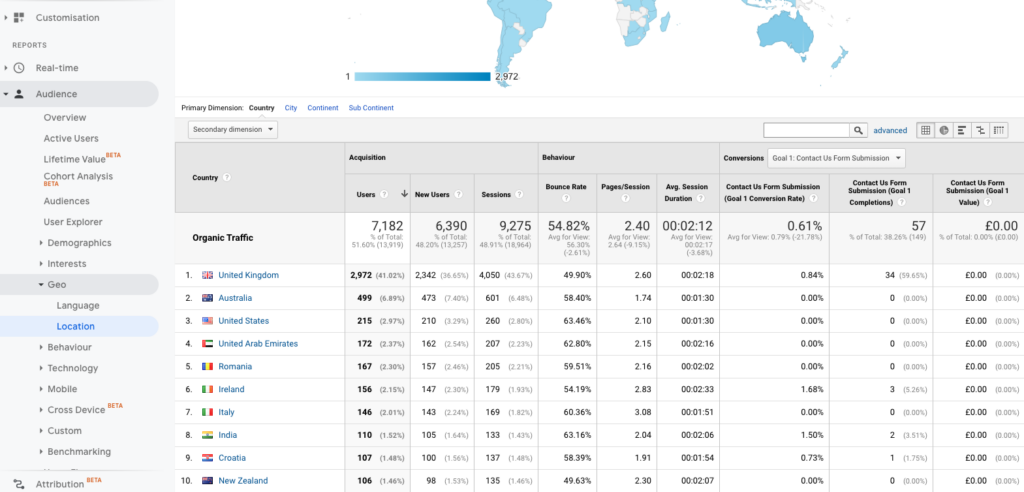
The above snapshot shows the total organic users visiting a UK website over the Q4 period of 2019. We can see that out of almost 7,182 visitors, 499 were from Australia. This is a great tool to use when determining what countries are driving traffic to your site.
Top tip: You may notice that a large number of your users are coming from a different country but are bouncing when they find that your original UK site doesn’t cater to their needs. In this case, there could be a case for moving to capture some of this market.
What if I’m not getting the organic traffic but I know there’s a market?
Getting data through your own organic channels is not the only indicator of market potential. So if you don’t have any, no problem. To assess the state of your niche in a given location, you can use a proxy VPN site to mask your native IP address which will allow you to access local SERPS eg. google.de.
Entering keywords that best describe your business can give you a basic idea of what competitors are also targeting your niche. Below is a google.de search for “electric guitars in Munich”.

Using the site explorer function in Ahrefs, you can then enter the URL of each competitor to harvest valuable information relating to organic traffic numbers.
Below is the information on the top result for Munich based guitar shop www.mjguitars.de.
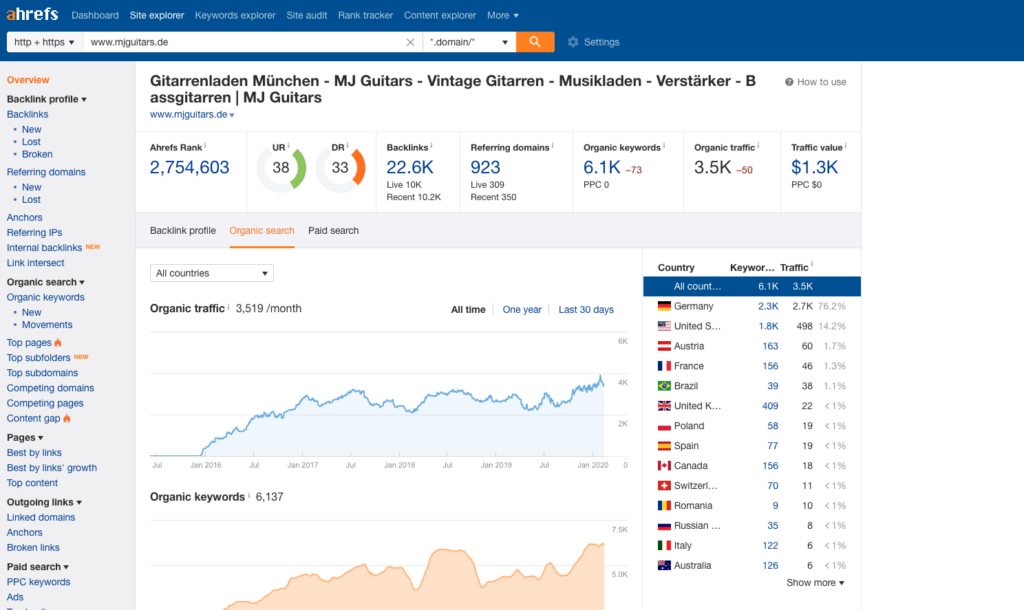
Local competition
A thorough competitor analysis will form the backbone of international SEO best practice. Looking at what established competitors are doing in your desired region(s) is essential. It can provide you with an insight into what is working in terms of things like:
- content
- colour schemes
- tone of voice
- keywords
- site architecture
More importantly, this practice will allow you to view the density of your niche in that particular market. It may be that the local players have a stranglehold for certain things – but have neglected an area you could exploit.
Language vs region targeting
Having discovered a credible demand for your products or services abroad, you need to make an important distinction. Is your business going to be targeting speakers of a certain language worldwide? (eg. French speakers in France, Canada, Belgium, Switzerland, Vietnam), or will it be targeting consumers on a strictly regional level (eg. just Russian speakers in Russia).
Often, targeting language alone lends itself more to product-based companies. This is because there could be customers in multiple countries that share the same language as per the French example above.
Can you fulfil the demand?
Imagine you walked away from this article, fine-tuned your international SEO strategy and got the results you had dreamed of. Would you be able to physically fulfil the demand if it came through? This applies to any kind of business whether it’s having enough technically skilled staff in a country to deliver a service, or the logistical clout to start internationally shipping your eCommerce products.
Your service/product delivery arm needs to be up and ready to go from the moment that your regional site(s) goes live. All it takes is a few bad reviews and already your fledgeling brand is attracting negative attention. Repairing damaged credibility is incredibly difficult and expensive, so make sure you are ready to serve your target market from the word go.
Cultural & historical heritage
Take time to research the cultural and societal norms of your target region. It’s vital to understand how what you’re offering syncs up with the country as a whole.
For example, a UK based stiletto maker may attract global traffic from Pakistan but the regional culture is very conservative when it comes to appearance. Trying to set up a presence in this region would be at ends with cultural norms.
Website layout & technical considerations
When you have a solid idea of the region and/or language you wish to target, it’s time to start laying the technical foundations of your international SEO campaign.
Every successful international SEO campaign is built on a strong technical foundation. This is what goes on underneath the bonnet of your website to ensure that a site is as crawlable and easy to understand in the eyes of a search engine.
International SEO URL structure
There are three different options for URL structures when it comes to choosing an international site
- Country code top-level domains (ccTLDs)
- Sub-domains
- Sub-directories
The pros and cons of each are still hotly debated in the SEO community but ultimately, it comes down to your company, what it offers, the size of your planned expansion and budget.
The below table shows what each option is, along with its pros and cons:
| URL Structure | What are they? | Pros | Cons | Best suited for |
| Country-code top-level domains (ccTLD) | A URL signifying which country/state a website is registered eg example.au | Clearest way of showing search engines that a website is specifically intended to serve users from a dedicated state/country. Higher CTRs for sites that are aligned with relevant ccTLDs so hugely powerful for local SEO. | High set-up cost and resource intensive with regards to maintenance. If using multiple ccTLDs for the same brand, the authority will need to be separately built up on each. Does not take into account the language spoken by the searcher eg. a French speaker in Australia. | Large international brands that want to rank in different geographical locations. Have extensive resources to build up localised SEO activities eg. link building, content writing and general website maintenance. Companies wishing to target single language-speaking countries. |
| Sub-domains | A separate section of a larger website designed to host specific content. | Easy to set up Can be used to target different languages. Can use geo-targeting to target each subdomain to different countries eg. es.example.com to Spain, Mexico, Argentina etc. | Viewed as a different entity to the root domain. Authority needs to be built from scratch. Association with a particular country is less clear to search engines. Don’t hold as much comparative authority as a ccTLD. | Great for a company that does not have such a large international presence. A business with limited resources when it comes to developers, content creators and SEOs. A business that does not offer products or content that are region/location-centric. |
| Sub-directories | Content stored in a folder destination on a single route domain. | Authority is passed on from the route domain. Very cheap and easy to set up Search Console can be used to geo-target each sub-folder. | Users may have a bias against clicking onto a site that is not coded with their country domain ISO code. | Your site offers universal content and or products/services. Site structure does not vary for foreign versions. Your original root site has lots of quality links and strong authority. |
Use “hreflang” tag to tell Google which language you’re targeting
CcTLDs are automatically programmed to appear in the language of whatever country is signified in the URL ISO prefix (this is the location abbreviation the domain name). For example, www.example.fr will automatically appear for searches formulated in France and will quite rightly serve up a French-language site.
However, you might have a generic international site with multiple language version pages. A good example is Audi’s website. It’s a generic .com domain available in both English and German (https://www.audi.com/de & https://www.audi.com/en). This makes sense – the brand is international but needs to cater to the language of its home market (Germany) and to the large swath of English-speaking customers around the world. Therefore, Audi needs to make sure that from their generic .com site, both German and English speakers are served with the right language version of the site. Enter the Hreflang tag.
What is a Hreflang tag?
The Hreflang HTML attribute is a way to tell Google that there are other versions of a page intended for different languages. It’s important to add this for international SEO efforts because it will serve the correct language version of a page to a user depending on location.
Cultural Considerations In Site Design & UX
Depending on your choice of site structures as outlined above, you will need to consider the site architecture in the context of your targeted region, what your site offers and any cultural attributes that may impact user experience.
This is an often overlooked area of site set-up when it comes to international SEO, but site engagement rates are hugely affected by colour, font and page structure depending on where the users are from.
Colour schemes in different counties
Colour is really important when it comes to design and international success. Let’s say you’re setting up a Brazilian site for your baby clothing business. While your UK site may be heavily themed on purple, that colour has deep-rooted meanings of loss and mourning in Brazil. Therefore it could be seen as inappropriate and off-putting to customers.
To highlight the reality of this, Smart Insights uses a great example of how the Singaporean version of education provider “Hotcourses” used orange to A/B test action buttons. For both Buddhist and Tamil ethnicities, orange is associated with wisdom and knowledge, and using this colour on signup buttons yielded a 134% increase in CTRs.
Different cultures respond to different content formats
Another thing to consider is how users from different regions will expect to receive content.
Yoast published an article highlighting the cultural differences between US & Dutch dentists websites. They found that for the same industry, there was a surprising difference when it comes to use of site features such as video, slideshows, testimonials and onsite social media displays.
Be aware of your audience’s cultural expectations
The table below shows five of Hofstede’s Six Dimensions of Culture dimensions. This is essentially a benchmark of collective behaviour profiles for different nationalities. Each benchmarking factor is as follows:
- PD (Power distance index) – The level of inequality between people with and without power
- IDV (Individualism vs collectivism) – The strength of ties individuals have with the wider community outside their core family unit
- UAI (Uncertainty Avoidance Index) – How well individuals cope with anxiety
- LTO (Long- Versus Short-Term Orientation) – What individuals see as important, short/long term goals
- MAS – (Masculinity) – The dominance of a masculinity/patriarchal influence in society
The table illustrates how key behavioural traits and attitudes can vary from culture to culture. These findings can be used as a guide when considering your choice of imagery, tones of voice, link building strategy and wider approach to UX.
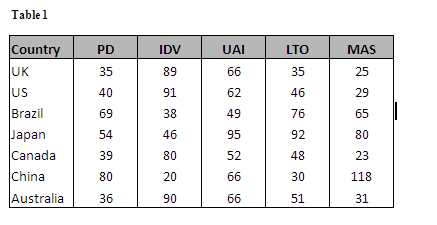
Consider the 4G speed in different countries for mobile content
You should also be aware that 4G load times around the world are vastly different. This poses a challenge for mobile load speeds. While countries like Japan and Korea boast the fastest mobile internet loading capabilities, other locations are less technically refined and might struggle to load excessively heavy sites resulting in poor user experience.
While it’s accepted that Google doesn’t completely dominate search engine market share in every global region (Russia, Yandex, China, Baidu), it still owns above 95% of the market in many countries where 4G capability tails off. With mobile-first indexing continuing as a huge ranking factor for Google, any sites serving these slower 4G regions still need to deliver the best content to users quickly and in a mobile-friendly format in order to rank.
International SEO Keyword Research
Language and culturally targeted keyword research is essential to any region-focused SEO effort. International keyword research, in particular, is all about nuance, language and cultural personalisation.
Below we highlight some of the key things you need to consider when carrying out international SEO keyword research.
Never use the same list of keywords for all regions
Under no circumstances copy and translate keywords meant for one language website to another.
The goal of any keyword research exercise is to identify the way in which people seek out the desired result be it a product, information or an answer. The way queries are structured changes significantly from region to region and language to language. This is because of the physical differences in linguistic structure between certain languages eg. the sequential placement of questions, verbs and nouns.
In addition to this, general cultural differences can also mean that some words in one language simply don’t exist in another.
Look at local search engine dominance
Depending on what regions your website seeks to target, you might find that Google is not the most widely used search engine.
In Russia, Google holds 46% of the total market and only 3% in China. Alternatives such as Yandex are more widely used and most importantly use completely different crawl and index algorithms to Google based on linguistic and cultural considerations as described previously.
The data collected for queries that lead to similar things will be vastly different from your native data, so search volumes will also vary. Using local keyword research tools (such as Yandex Keyword Statistics) in a non-Google dominated market is essential.
Think about user intent – not just keyword volumes
Intent-based keyword research should rule every keyword research process, but for international strategies, it’s even more important to focus on it over keyword volumes.
With BERT to come into full effect, (read more about that here) targeting niche, highly intent-driven terms is better than targeting short tail/long vol terms.
Creating content for international sites
Regardless of what regions and languages your international website serves, your content needs to be relevant and value additive to those local searchers.
As always, content should be unique, written in the correct native language and based on localised intent data found from keyword research (see above). Your sole aim in any international SEO campaign should be to persuade a localised population that your offer is the best option for them amongst all other competitors.
As a foreign entity trying to grab a piece of the pie, you’ll have to be hugely attentive to your audience and their needs.
Use local translators & market specialists for content
Ensuring your brand values and USPs resonate correctly across a different culture is much more complex than digital translation. You should employ professional translators who know the social/societal characteristics of the location/culture that website is trying to target. This will allow you to understand that culture’s behaviours, attitudes and market nuances so that you can adapt your online content accordingly.
Never duplicate content
Unique content is essential even if your business owns multiple same-language ccTLDs (country-coded top-level domains) for different regions (eg. example.co.uk, example.ca, example.nz). Whilst ccTLDs are prized for sending the strongest signal to search engines with regards to location relevancy, using duplicate content across them can cause problems.
When surveymonkey.com began appearing for UK based brand searches, Google’s John Mueller pointed out that in the case of two ccTLD using duplicate content, Google will sometimes return the results of the strongest one regardless of location. This shows that duplicate content is still an in international SEO faux pax even if used over same-language sites.
Generate local backlinks
Backlinks will always play a huge part in all forms of local, national and international SEO. They’re a signal of credibility, trustworthiness and site value, and are one of Loom’s 4 pillars of SEO.
Securing good quality backlinks from local sources relevant to your niche should be at the core of your link building strategy. Our look into different site structures for an international site conclusively reveals that regardless of whether you chose a ccTLD, subdomain or subfolder, links still need to be built to each separate entity in order to build up its authority and rankings.
Let’s say your business is a UK-based fitness equipment company that has multiple ccTLDs for countries like France, Spain, Germany, Italy & US. If I wanted to appear for kettlebell related queries from French users, my job would be to show Google that my example.fr site is the most relevant provider of anything to do with kettlebells eg. different weights, colours, competition bells/practice bells for a French customer. But – there’s one problem, all of the links pointing to my site come from US & UK-based fitness bloggers! This does not give Google the impression that my site has a local vote of confidence, so it’s very unlikely that it will rank as such.
Adopt a local mindset to help build local links
A strong and relevant backlink profile is not made overnight. It should reflect how well your business is integrating and appealing to local customers.
That said, assimilating the market space in terms of what worthy local publications, high-value influencers and potential partners is essential in spotting valuable link opportunities.
Local digital marketing specialists can really add value here as they will be able to provide a unique understanding of the regional market including, players, influencers and worthy publications.
Paying for local assistance help may seem like an expensive investment at first, but gaining just a few high-quality links can result in higher local SERP positions, higher conversion rates and higher sales!
International SEO tools
Here’s a list of SEO tools that you can use to help plan your international SEO strategy.
- Google Keyword Planner
- Yandex Keyword Planner
- Baidu Keyword Planner
- Statista
- Google Shopping Insights
- Google Analytics
- Google Trends
- SEM Rush
- The International SEO ROI Calculator
International SEO strategies at Loom Digital
Expanding a company internationally is a big step – but the rewards of doing it correctly can be huge. Any international SEO strategy starts with your ambitions, budget, resources, logistical capability and viability of your offer in a given location. From this, you can then adapt and plan your strategy accordingly.
The key takeaway for a successful international SEO campaign is personalisation – getting inside the minds of your target audience and cross-referencing cultural, geographical, political and linguistic factors to determine how they’ll locate you.
Crucially, a well-rounded international SEO campaign is simply just regular SEO – in a non-native context!
If you’re thinking about expanding your online presence into foreign markets, our SEO experts can help. Our Bristol-based SEO experts have a combined expertise of nearly four decades, and are skilled in planning and executing complex, bespoke SEO strategies that help your businesses expand online.
Contact Loom Digital today and talk to our experts about your international SEO vision. Call on 0117 923 2021 or send us an email at [email protected].


